
Classifying concrete object according to attributes - Mathematics Instructional Plan
- Subject:
- Mathematics
- Material Type:
- Lesson Plan
- Provider:
- VDOE
- Author:
- VDOE
- Date Added:
- 10/03/2024

Classifying concrete object according to attributes - Mathematics Instructional Plan

Exploring patterns - Mathematics Instructional Plan

Exploring equivalencies - Mathematics Instructional Plan

Determine slope as a rate of change in a proportional relationship between two quantities; Write equations in the form y=mx to represent a proportional relationship; Graph lines representing a proportional relationship - Algebra Readiness Remediation Plan

Determine the y-intercept in an additive relationship; write an equation in y=x+b form; graph a line representing an additive relationship - Algebra Readiness Remediation Plan

Determine the y-intercept in an additive relationship between two quantities; Write an equation in y=x+b form; Graph a line representing an additive relationship - Algebra Readiness Remediation Plan

Model and discover the distributive property to simplify expressions - Algebra Readiness Remediation Plan

Evaluate algebraic expressions using physical representations of numbers as replacement values of variables - Algebra Readiness Remediation Plan

Practice evaluating expressions using order of operations and variables - Algebra Readiness Remediation Plan

Solve two step linear equations in one variable - Algebra Readiness Remediation Plan
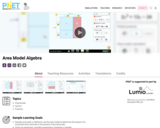
Build rectangles of various sizes and relate multiplication to area. Discover new strategies for multiplying algebraic expressions. Use the game screen to test your multiplication and factoring skills!
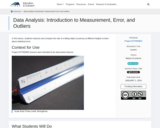
In this lesson, students measure and compare the rate of a falling object (a penny) at different heights to learn about statistical error.
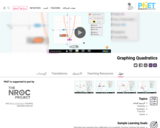
Learn about graphing polynomials. The shape of the curve changes as the constants are adjusted. View the curves for the individual terms (e.g. y=bx ) to see how they add to generate the polynomial curve.
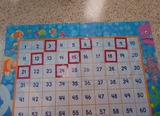
The purpose of this lesson is to help students develop their understanding of algebra using the patterns of multiplcation that occur on a hundreds board. This is an effective strategy that will help students develop an understanding of multiples which is very crucial in 4th grade and above. It also reinforces mutiplication as repeated addition. This is also an effective strategy to use with English Language Learners, Special Educational Students and struggling learners because it provides a hands-on, interactive format for the whole class to see and participate.This lesson is also very engaging and it promotes most of the 5 C's: critical thinking, creative thinking, collaboration, communication, and citizenship.Use the following sites to look at 2 products that I have used from EAI and Didax.https://www.eaieducation.com/Product/504038/Make_a_Splash%e2%84%a2_120_Mat_Floor_Game.aspx (see image)https://www.didax.com/hip-hoppin-hundreds-mat.html
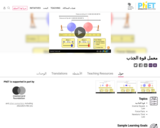
Visualize the gravitational force that two objects exert on each other. Change properties of the objects in order to see how it changes the gravity force.

This is a collection of journal prompts for algebra topics in Desmos activities.

This is a booklet containing 37 space science mathematical problems, several of which use authentic science data. The problems involve math skills such as unit conversions, geometry, trigonometry, algebra, graph analysis, vectors, scientific notation, and many others. Learners will use mathematics to explore science topics related to Earth's magnetic field, space weather, the Sun, and other related concepts. This booklet can be found on the Space Math@NASA website.

Repeated motion is present everywhere in nature. Learn how to 'make waves' with your own movements using a motion detector to plot your position as a function of time, and try to duplicate wave patterns presented in the activity. Investigate the concept of distance versus time graphs and see how your own movement can be represented on a graph.

Video Description: How does NASA test ideas, like the Mars Helicopter, before they are even built? Find out more about this revolutionary helicopter and how NASA uses mathematical modeling to turn complex ideas into solvable equations that help shape future missions. Video Length: 3:20.NASA eClipsTM is a suite of online student-centered, standards-based resources that support instruction by increasing STEM literacy in formal and nonformal settings. These free digital and downloadable resources inform and engage students through NASA-inspired, real-world connections.NASA eClips Real World segments (grades 6-8) connect classroom mathematics to 21st Century careers and innovations. They are designed for students to develop an appreciation for mathematics through real-world problem solving.

See how the equation form of Ohm's law relates to a simple circuit. Adjust the voltage and resistance, and see the current change according to Ohm's law. The sizes of the symbols in the equation change to match the circuit diagram.